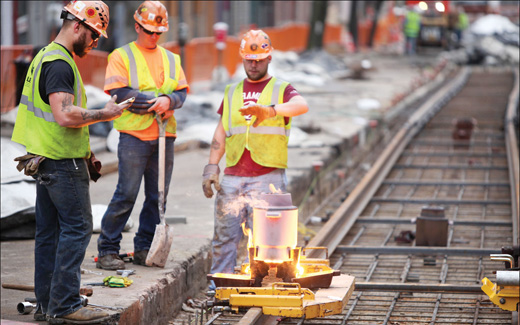
WASHINGTON – On-the-job deaths rose from 2013 to 2014 in construction and in the oil and gas industry, the Labor Department reported, while the rate of fatal occupational injuries nationwide stayed unchanged in those two years. And more workers aged 55 and older died on the job last year than ever before.
DOL said preliminary data for last year show 4,679 workers were fatally injured on the job, up two percent from final data from 2013, when 4,585 died. But the fatalities among the oldest workers rose 9 percent, from 1,490 in 2013 to 1,621 last year.
Construction injuries – many of them falls – killed 874 workers last year, up from 828 the year before, the Bureau of Labor Statistics reported. But the death rate fell by 0.2 deaths per 100,000 workers in construction, to 9.5 deaths last year. BLS said that’s because construction, now recovering from the Great Recession, saw a large boost in working hours.
The construction death rate is still triple the death rate among all workers from occupational injuries, which was 3.3 per 100,000 last year, unchanged from 2013.
“Far too many people are still killed on the job — 13 workers every day taken from their families tragically and unnecessarily. These numbers underscore the urgent need for employers to provide a safe workplace for their employees as the law requires,” Labor Secretary Thomas Perez warned.
Increased deaths in construction and oil and gas are “why OSHA continues extensive outreach and strong enforcement campaigns in these industries,” he added. “The Department of Labor will continue to work with employers, workers, community organizations, unions and others to make sure that all workers can return home safely at the end of every day.”
BLS said 181 oil and gas extraction workers died on the job last year, 17 percent more than the year before. That industry’s death rate was 14.1 per 100,000 workers, second only to agriculture, forestry, fishing and hunting (24.1 deaths per 100,000 workers) in fatality rates.
The most-dangerous occupations last year were loggers (109.5 fatalities per 100,000 workers), fishers and related occupations (80.8), aircraft pilots and engineers (63.2) and roofers (46.2).
Some of the most economically vulnerable workers are also among groups with high on-the-job death numbers. Perez called 789 Hispanic-named workers who died on the job last year a figure that’s “unacceptably high.” And 827 of 2014’s dead workers were foreign-born.
And 797 contracted workers died on the job in 2014, up from 749 in 2013. More than half of the “contractors” who died last year (415) were in construction.
The number of fatal injuries rose in Arkansas, Colorado, Georgia, Hawaii, Idaho, Kansas, Louisiana, Michigan, Mississippi, Nebraska, New Hampshire, New York (and New York City), both Dakotas, Ohio, Oregon, Tennessee, Texas, Utah, Vermont, Washington, and Wyoming. Deaths almost tripled, from 11 to 31, in Hawaii. The biggest decline was in D.C., from 25 deaths in 2013 to 11 last year.
Photo: Liz Dufour/AP

MOST POPULAR TODAY


Zionist organizations leading campaign to stop ceasefire resolutions in D.C. area

High Court essentially bans demonstrations, freedom of assembly in Deep South

Afghanistan’s socialist years: The promising future killed off by U.S. imperialism

Communist Karol Cariola elected president of Chile’s legislature






Comments